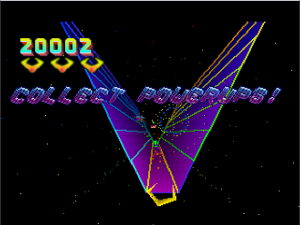88th game played so far
Genre: Shoot ’em Up
Platform: Atari Jaguar
Year of Release: 1994
Developer: Atari
Publisher: Atari
Ah the early nineties. It was a simpler time with a recession, no iPods, John Major was the Prime Minister and game titles contained multiples of 1000 in order to look futuristic.
Tempest 2000 is the only game on the list whose home is the Atari Jaguar console (god bless the PC port) and is actually a sequel and remake of the 1981 shoot ’em up game Tempest with improved graphics, music and levels. The man behind this, Jeff Minter, is the brains behind games we will later encounter on this list so… watch this space!
Our Thoughts
This is one of those games that just allowed for simple fun. Lots of shooting creatures, with your only mission not to get confused with what way is left and which is right when you go in a circle. Once you get past the initial level you begin to long for the circle levels as the difficulty ramps up. It’s a shoot ’em up, shooting lots of approaching enemies is what you do in these games and the main special draw in this game is, well, the perspective. Instead of approaching the enemies on a 2D game, here they come crawling up from the centre of the screen.
In earlier levels the terrain is a simple one, i.e. a straight line and a circle, which means that it is fairly easy to gauge the origins of the enemy. However, in later levels the terrain gains all types of folds, nooks and crannies it gets harder and harder to figure out where the enemies will end up. It’s an interesting thing about this game that as you progress the difficulty level can ramp up suddenly, then dip and slump then ramp up again. It always keeps you on your toes and, despite the simplicity of the game, keeps things interesting.
Games such as Tempest 2000 thrive on a simple gameplay so in order to up the ante they need to make themselves distinctive in some way; otherwise there would be no reason for them to be on this list. The most noticeable way this has been done is the impressively apt soundtrack that has been used to accompany the levels which is a marriage between synths and club beats or, if we’re being honest, eighties and nineties music. The soundtrack not only works well (and fits in with what I remember of the music at the time), but adds to the gameplay. It heightens the tension and speed of the game, making it feel like you have even less time to get to the enemies and defeat them than you already have. It might not have been necessary, but it certainly adds to the game. I think it is necessary since the beats definitely cause your heart to race that little bit more thus increasing the adrenaline rush the game can inspire.
The graphics help here as well. By using vector graphics, any unnecessary distractions are removed, and you’re left to focus on the enemies and environment, meaning that the danger becomes more real. Add to that the lack of distracting surroundings and making it hard to see whether the enemy’s approaching from the fourth or fifth lane from the right, and you have a challenge in itself.
As you delve further into the game the games bestiary expands to include such lovable enemy staples such as ‘the one that splits in two when you shoot it’ which, due to quick pace set by the game, can be mighty stressful. There is such a rush when you finish the level which is followed by the slightly deflating thought of “oh crap what the hell will the game throw at me now”.
In that sense the game is strangely addictive, creating its excitement through adrenaline, excitement and worry.
Final Thoughts
Vector shooters are by their nature very simple games, but if video games have taught us anything (and we all know they have) it is that simple is not a negative quality. By combining simple goals with distinctive graphics, good music and an a rather nifty difficulty curve Tempest 2000 has been a good surprise.

[…] how seamless loading is (after the first half hour of loading during which we wrote up part of the Tempest 2000 […]
[…] time! We played the sequel of this game before, as Tempest 2000. Familiarity may […]